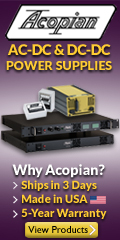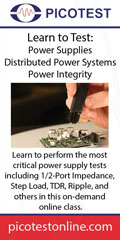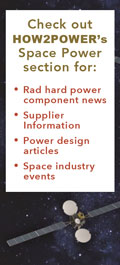 |
|
IN THIS ISSUE:
» The Engineer’s Guide To EMI In DC-DC Converters (Part 18): Advanced Spread-Spectrum Techniques
» Developing A 25-kW SiC-Based Fast DC Charger (Part 4): Design Considerations And Simulation Of The DC-DC Stage
» Focus On Magnetics:
PSMA Magnetics Workshop Explores AI, Core Loss And EMI
» Spotlight On Safety & Compliance:
Predicting Mission Life Performance And Reliability Of Rad-Hard Power Electronics
» New Power Products
» Industry Events
» Other Top Power News
From the Editor's Desk David G. Morrison
Editor, HOW2POWER TODAY

Despite the rapidly expanding world of New Space applications, which is open to use of commercial, plastic-packaged parts, the opportunities for traditional rad-hard electronics with hybrid assembly and hermetic packaging, are not going away. An article in this month’s Safety & Compliance column by Peter Lee gives us a glimpse of the design analysis methodology that one vendor uses to develop its rad-hard hybrid dc-dc converters. An integral part of this story is MIL-PRF-38534 Class K, which governs how the company provides end-of-life verification for its product. MIL-STDs or MIL SPECs like this one and MIL-STD-883, for example, have been around for decades, but they are not static. A tutorial hosted earlier this year at CMSE, “Overview of Component Specs for Military & Space Electronics,” offered three excellent presentations that covered the history of relevant MIL-SPECs, how they are evolving, and details on how these standards relate to active and passive component specs. With most conferences offering their content virtually, more engineers now have the opportunity to attend such training and hopefully this will continue going forward. Meanwhile, engineers can also learn about how various standards are applied from articles like Lee’s and part 18 of Tim Hegarty’s “Engineers Guide to EMI in DC-DC Converters,” which discusses advanced spread-spectrum techniques. This is the final installment in this newsletter’s longest-running series to date. Hegarty’s series discussed nearly all aspects of designing and testing dc-dc converters to reduce EMI and achieve EMC in automotive and industrial applications. The desire for a forum in which such comprehensive and practical works could be readily published, was one of my motivations for launching How2Power.com. This month marks the website’s 12th anniversary. Special thanks go out to all the authors and supporters who made this possible!
|
|

|
HOW2POWER EXCLUSIVE DESIGN ARTICLES 
|
The Engineer’s Guide To EMI In DC-DC Converters (Part 18): Advanced Spread-Spectrum Techniques
by Timothy Hegarty, Texas Instruments, Phoenix, Ariz.
Power electronic converters normally operate at a fixed switching frequency, which causes concentrated harmonic peaks in the frequency domain. By applying spread spectrum modulation, the switching frequency varies in the time domain such that the power of the distinctive harmonics spreads in the frequency domain, decreasing the respective peak spectral values. Part 9 offered an insight into periodic spread-spectrum techniques to provide a systematic reduction of conducted and radiated emissions, while referring specifically to an implementation using a triangular modulation profile. This article describes an enhanced multirate spread-spectrum technique developed by Texas Instruments that suppresses both acoustic and electromagnetic noise using a combination of periodic and pseudo-randomized modulations. This hybrid technique, known as dual random spread-spectrum, enhances EMI performance across the multiple resolution bandwidth settings specified in automotive EMC tests such as CISPR 25 and EN 55025.
Read the article…
|

Compared with classic triangular
modulation, the proposed spread-spectrum
technique, DRSS, redistributes the energy
in the noise spectrum more effectively. |

|

A foundational step in designing
the DAB-PS converter is the selection of
the key parameters for the transformer
and the resonant inductor. For example,
the turns ratio of the transformer
significantly affects converter efficiency. |
Developing A 25-kW SiC-Based Fast DC Charger (Part 4): Design Considerations And Simulation Of The DC-DC Stage
by Oriol Filló, Karol Rendek, Stefan Kosterec, Daniel Pruna, Dionisis Voglitsis, Rachit Kumar and Ali Husain, ON Semiconductor, Phoenix, Ariz.
In this new installment of “Developing A 25-kW SiC-Based Fast DC Charger,” the spotlight is on the dc-dc dual active bridge phase-shift (DAB-PS) zero voltage switching (ZVS) converter, as introduced and partially described in part 2. Here the authors present some of the design process for the dc-dc stage followed by their engineering team. In particular, they explain key design considerations and tradeoffs in developing such a converter, especially around the definition of the magnetic components, and discuss the power simulations and design decisions made. In this part 4, they also touch on the concept of flux-balancing in a transformer and how it has been addressed for this 25-kW fast dc charger.
Read the article…
|


FOCUS ON MAGNETICS 
Sponsored by Payton Planar Magnetics
A monthly column presenting information on power magnetics design, products, or related technology |

PSMA Magnetics Workshop Explores AI, Core Loss And EMI
by Dennis Feucht, Innovatia Laboratories, Cayo, Belize
On June 2-3, 2021, the Power Sources Manufacturing Association (PSMA) Magnetics Committee and IEEE PELS held their annual pre-APEC workshop on progress in high-frequency magnetics for power conversion. Presenters ranged from PhD students to magnetics professors to magnetics company sales engineers. As this was a virtual event presented via the Web, most of the presentations were essentially PowerPoint slides with audio. The emphasis in application was on EMI suppression, particularly on the first day, while the second day expanded toward frontiers in high-frequency converter design. Some of these advancements discussed were in circuits, but many of them were in magnetics. In this article, the author highlights some of the more interesting talks.
Read the full article…
|

 |
 |

SPOTLIGHT ON SAFETY & COMPLIANCE 
A monthly column discussing standards and regulatory requirements affecting power electronics |

Predicting Mission Life Performance And Reliability Of Rad-Hard Power Electronics
by Peter Lee, International Rectifier HiRel Products (IR HiRel), an Infineon Technologies company, San Jose, Calif.
In space applications, understanding equipment reliability and performance over the mission lifetime remains a critical concern for system designers, especially for long duration, interplanetary and other critical missions. To achieve confidence in space systems requires rigorous design, strict qualification and radiation testing, and controlled manufacturing and screening to eliminate manufacturing defects and infant failures. Providing performance validation over the life of the mission is addressed through extensive design analyses validated by empirical data. Doing the detailed end-of-life performance assessment requires time, resources and expertise in radiation-hardened (rad-hard) electronics. This article will explain IR HiRel’s design analysis methodology for its rad-hard hermetic hybrid dc-dc converters that power spacecraft electrical subsystems. This method provides end-of-life verification of the dc-dc converter specifications and performance in accordance with MIL-PRF-38534 Class K.
Read the full article…
|

 |

|

 |
|
|

 — POWER PRODUCTS IN 3 IMAGES OR LESS — POWER PRODUCTS IN 3 IMAGES OR LESS 
|


Efficient Power Conversion’s
EPC9149 reference design and
demo board. |
Bus Converter Reference Design Packs 1 kW Into Eighth-Brick Footprint
 Diagram: The reference design and demo board for a 48-V to 12-V bus converter exploits the efficiency of the company’s GaN FETs to deliver 1 kW in an eighth-brick format, achieving a power density of 1,226 W/in3. Diagram: The reference design and demo board for a 48-V to 12-V bus converter exploits the efficiency of the company’s GaN FETs to deliver 1 kW in an eighth-brick format, achieving a power density of 1,226 W/in3.
 Graph: The peak efficiency in converting 48 V to 12 V is 98% and the full load efficiency at 12 V when delivering 1 kW, is 97%. Graph: The peak efficiency in converting 48 V to 12 V is 98% and the full load efficiency at 12 V when delivering 1 kW, is 97%.
See the full story…
|


 |

|


ON Semiconductor’s
NCP1680 CrM PFC
controller IC. |
Totem-Pole PFC Controller Provides High Performance, Cost Effective Design
 Diagrams: The CrM totem-pole PFC controller is capable of constant on-time CrM and valley synchronized frequency foldback for optimized efficiency across the entire load range. This device enables power supply designs for telecom 5G, industrial and high-performance computing, that operate with universal mains (90 to 265 Vac) at recommended power levels up to 350 W. Diagrams: The CrM totem-pole PFC controller is capable of constant on-time CrM and valley synchronized frequency foldback for optimized efficiency across the entire load range. This device enables power supply designs for telecom 5G, industrial and high-performance computing, that operate with universal mains (90 to 265 Vac) at recommended power levels up to 350 W.
See the full story…
|


Maxim Integrated Products’
MAX16162 nanoPower supervisor. |
Supply Supervisor Delivers Glitch-Free Power-Up Down To 0.6 V And Lower
 Diagram: The nanoPower supervisor’s reset stays low during rampup of the supply voltage from the regulator so that there’s no undefined region or glitch. The IC is available with thresholds from 0.6 V to 4.85 V and boasts a low quiescent current of 825 nA and the option of a 1.06-mm by 0.73-mm wafer-level package. Diagram: The nanoPower supervisor’s reset stays low during rampup of the supply voltage from the regulator so that there’s no undefined region or glitch. The IC is available with thresholds from 0.6 V to 4.85 V and boasts a low quiescent current of 825 nA and the option of a 1.06-mm by 0.73-mm wafer-level package.
See the full story…
|



Renesas Electronics’ RAA2230XX
buck regulators. |
700-V, 2-W To 8-W Buck Regulators Suit A Range Of Home And Industrial Uses
 Diagram: Typical buck application circuits for the RAA223011 (4 W) and RAA223012 (2 W) and RAA223021 (8 W). These regulators feature low power consumption, low EMI, no audible noise, and reduced BOM costs. They target a wide range of applications, including home appliances, sensing systems such as smoke alarms and gas sensors, white goods, power meters and industrial controls. Diagram: Typical buck application circuits for the RAA223011 (4 W) and RAA223012 (2 W) and RAA223021 (8 W). These regulators feature low power consumption, low EMI, no audible noise, and reduced BOM costs. They target a wide range of applications, including home appliances, sensing systems such as smoke alarms and gas sensors, white goods, power meters and industrial controls.
See the full story…
|

|










|


 |

|

INDUSTRY EVENTS  |
|
APEC 2021 Presented Novel Concepts For Energy Storage, Million-RPM Motor Transmitter
by Dennis Feucht, Innovatia Laboratories, Cayo, Belize
One of the two main power-electronics conferences and expositions held annually in America is the Applied Power Electronics Conference, held this year in cyberspace. APEC is vast, with a multitude of papers, both technical and industrial, with presenters from both academia and industry. This report selectively highlights talks from two of the sessions. In one of these sessions, an expert in the magnetics field looked ahead to new options for energy storage in power electronics, using piezoelectric and LC resonators. In the other, a researcher discussed a novel high-speed motor that creates a powerful low-frequency wireless transmitter by supplying mechanical energy to a permanent magnet antenna.
Read the full story… |

ECCE 2021 To Host Compelling Talks And Tutorials In Vancouver And Online
by David Morrison, Editor, How2Power.com
This year’s IEEE Energy Conversion Congress & Exposition (ECCE 2021) marks the 13th edition of this highly successful event, which is sponsored by the IEEE Power Electronics Society (PELS) and the IEEE Industrial Applications Society (IAS). After last year’s ECCE was held in a virtual-only format, many participants are eager to return to a physical event, and are looking forward to this year’s hybrid format. It will feature the familiar in-person conference and expo, which is to be held October 10-14, 2021 in Vancouver, Canada, in tandem with a virtual conference and expo hosted on the vFairs platform for those who cannot physically attend. In this article I’ll share highlights from the upcoming technical program.
Read the full story… |

|

43rd Annual EOS/ESD Symposium: The New Era For EOS & ESD
by Lorenzo Cerati, EOS/ESD Symposium Advisor
For many years the EOS/ESD Symposium has served as the world’s leading forum on electrostatic discharge and overstress. Attending the EOS/ESD symposium means having a unique opportunity to improve the EOS/ESD awareness and knowledge, expand your network of domestic and international industry colleagues working on any aspect of an EOS/ESD control or device programs, and be part of a best in class event. Even during these difficult times, the steering committee, the excellent staff at the ESDA headquarters, and all the great ESD volunteers made a remarkable effort to prepare this year’s event, which will be held September 26 - October 1, 2021 in Tucson, Ariz. offering a dense program packed with tutorials, exhibits, workshops, technical sessions, and invited talks.
Read the full story… |

PCIM Asia Conference 2021 To Feature Over 50 Papers
Asia’s leading fair in power electronics will be coming to Shenzhen’s World Exhibition & Convention Center from September 9 – 11, 2021, with its renowned accompanying conference to feature guest speakers’ talks on a variety of industry hot topics. PCIM Asia Conference 2021 has already confirmed 52 papers from experts in industry and academia to be used in oral & poster sessions, keynotes, tutorials and more during the event focusing on the latest insights and research within the sector. The conference promises to once again provide a platform for industry professionals in power electronics, intelligent motion, renewable energy and energy management from around the world to connect and share ideas.
Read the full story… |


 Cambridge GaN Devices hired Alain Charles to the board as part of the startup’s move towards delivering green electronics and reshaping the industry towards more sustainable practices. Cambridge GaN Devices hired Alain Charles to the board as part of the startup’s move towards delivering green electronics and reshaping the industry towards more sustainable practices.
 The Center for Power Electronics Systems (CPES) website has a new look with improved search functionality. The Center for Power Electronics Systems (CPES) website has a new look with improved search functionality.



 The call for papers is now open for the PCIM Europe Conference 2022. The call for papers is now open for the PCIM Europe Conference 2022.
 STMicroelectronics will partner Tower Semiconductor to accelerate the ramp-up of ST’s Agrate R3 300-mm analog and power fab to large volumes. STMicroelectronics will partner Tower Semiconductor to accelerate the ramp-up of ST’s Agrate R3 300-mm analog and power fab to large volumes.



ABOUT THIS NEWSLETTER: Thank you for reading HOW2POWER TODAY.
How2Power sends no more than one e-mail per month to registered users. Continuing your subscription ensures you'll receive future newsletters. Manage Your Subscription
©2020 All rights reserved. www.how2power.com
|
|